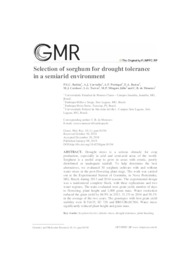Selection of sorghum for drought tolerance in a semiarid environment.
Selection of sorghum for drought tolerance in a semiarid environment.
Author(s): BATISTA, P. S. C.; CARVALHO, A. J.; PORTUGAL, A. F.; BASTOS, E. A.; CARDOSO, M. J.; TORRES, L. G.; JULIO, M. P. M.; MENEZES, C. B. de
Summary: Drought stress is a serious obstacle for crop production, especially in arid and semi-arid areas of the world. Sorghum is a useful crop to grow in areas with erratic, poorly distributed or inadequate rainfall. To help determine the best alternatives, we evaluated 30 sorghum cultivars with and without water stress in the post-flowering plant stage. The work was carried out at the Experimental Station of Gorutuba, in Nova Porteirinha, MG, Brazil, during 2013 and 2014 seasons. The experimental design was a randomized complete block, with three replications and two water regimes. The traits evaluated were grain yield, number of days to flowering, plant height and 1,000 grain mass. Water restriction reduced the grain yield by 68.9% in 2013, 31.2% in 2014 and 50.1% in the average of the two years. The genotypes with best grain yield stability were B.Tx635, SC 720 and BR012RxSC566. Water stress significantly reduced plant height and grain mass.
Publication year: 2019
Types of publication: Journal article
Unit: Embrapa Maize & Sorghum
Observation
Some of Embrapa's publications are published as ePub files. To read them, use or download one of the following free software options to your computer or mobile device. Android: Google Play Books; IOS: iBooks; Windows and Linux: Calibre.
Access other publications
Access the Agricultural Research Database (BDPA) to consult Embrapa's full library collection and records.
Visit Embrapa Bookstore to purchase books and other publications sold by Embrapa.

